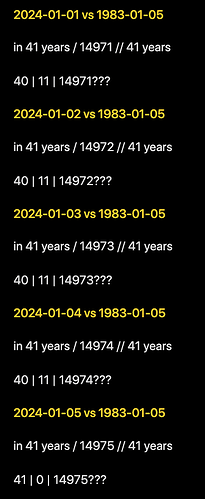I ran the following query in a note of its own:
Birthdate:: 1983-01-05
```dataview
TABLE WITHOUT ID
Birthdate, DeathDate as "Death Date",
ageDuration as Age, ageDuration.days as "Age days",
ageInDays, dur(ageInDays + "days"),
DeathDays, BirthDays, DeathDays - BirthDays, dur((DeathDays - BirthDays) + " days")
WHERE file = this.file
FLATTEN list(date(2024-01-02), date(2024-01-03), date(2024-01-04), date(2024-01-05)) as DeathDate
FLATTEN default(DeathDate, date(today)) - Birthdate as ageDuration
FLATTEN (number(dateformat(DeathDate, "x")) - number(dateformat(Birthdate, "x")))/86400/1000 as ageInDays
FLATTEN (DeathDate - date(1950-01-01)).days as DeathDays
FLATTEN (Birthdate - date(1950-01-01)).days as BirthDays
```
365 multiplied by 41 = `= 41 * 365`
And I got really confused… The various results differs from 41 years to 44 years and 6 months… And various variants in between those…
In short, date calculations are tricky. Very tricky. We as humans automatically do stuff related to years and leap years, months having 28 (29), 30 or 31 days, which is not as easy to do with computers. And it do seem like dataview is not very good at this stuff…
For a little read up on the topic, see Fix month and year diffs by timrwood · Pull Request #571 · moment/moment · GitHub
Would this be better using dataviewjs… Maybe? Maybe not?
I put together the following:
```dataviewjs
const birthDate = dv.current().Birthdate
for (let deathDateStr of ["2024-01-01", "2024-01-02", "2024-01-03", "2024-01-04", "2024-01-05"]) {
const a = moment(deathDateStr)
const b = moment(birthDate.toISODate())
dv.header(3, a.format("YYYY-MM-DD") + " vs " + b.format("YYYY-MM-DD"))
dv.paragraph( a.from(b) + " / " +
a.diff(b, "days") + " // " +
moment.duration(a.diff(b)).humanize({d: 365})
)
const yearDiff = a.diff(b, "years")
const monthDiff = a.diff(b, "months") - yearDiff*12
dv.paragraph( a.diff(b, "years") + " | " + monthDiff + " | " + a.diff(b, "days") + "???")
}
```
with the output of:
At least it can be persuaded into giving the correct number of years and month between the dates. But was that easy to achieve? Nope… Can we calculate the days part… Nah… Not in the time span I dedicated to answer this request. The days part is the really icky part since that needs to account for leap years, when in the year we’re currently at, which day of month we’re in, and so on…
The moment.js documentation does however indicate that it could show more humanize() variants of its duration, which should account for proximity in days across month boundaries and so on… So maybe?
This latter method, could however at least calculate the age in years and month accurately, using some variation over:
const yearDiff = a.diff(b, "years")
const monthDiff = a.diff(b, "months") - yearDiff*12
dv.paragraph( a.diff(b, "years") + " | " + monthDiff )
Hopefully this gives some hints as to the complexity and strangeness of date calculations. Sorry, it’s not the answer you might have wanted to have.
